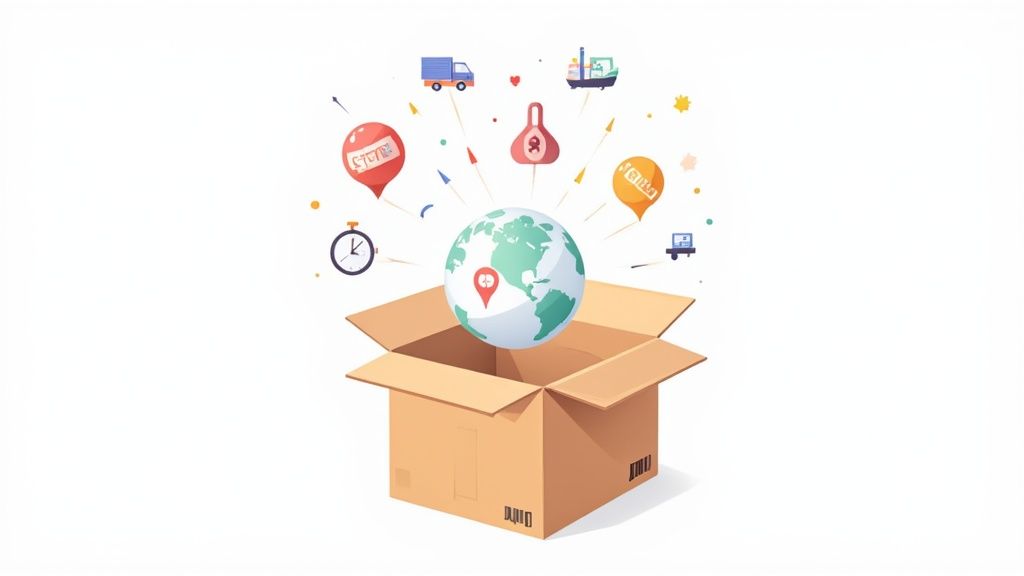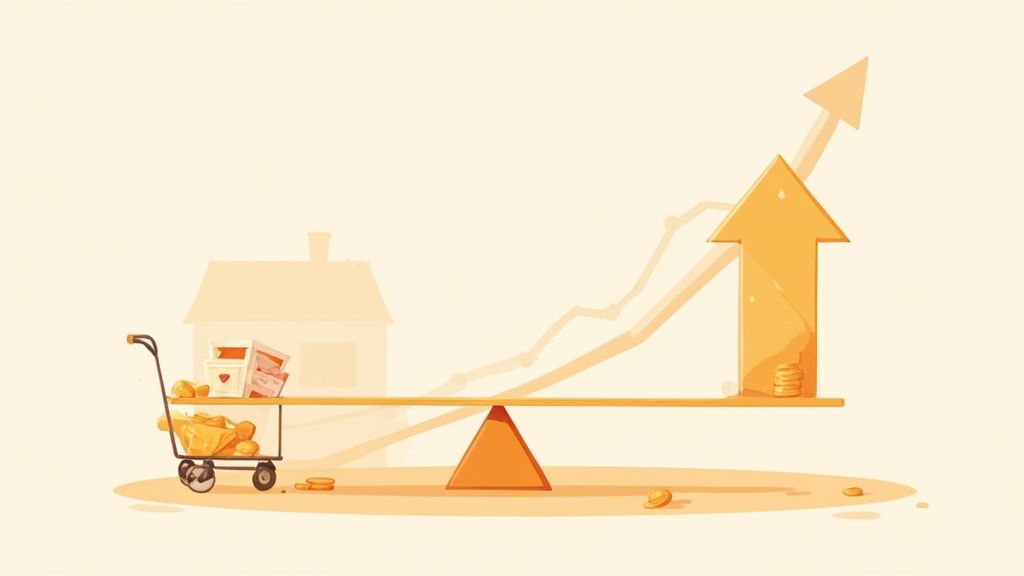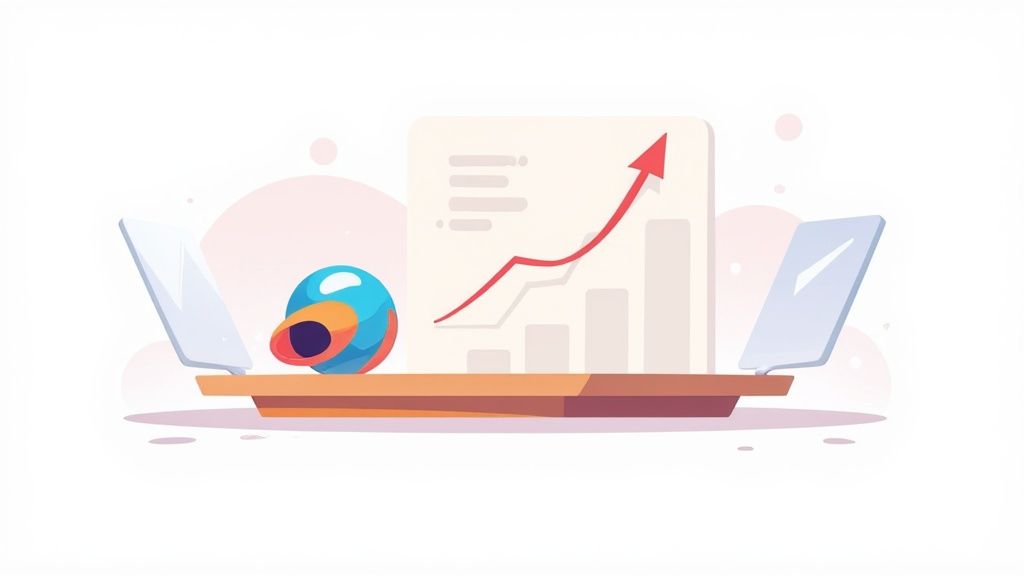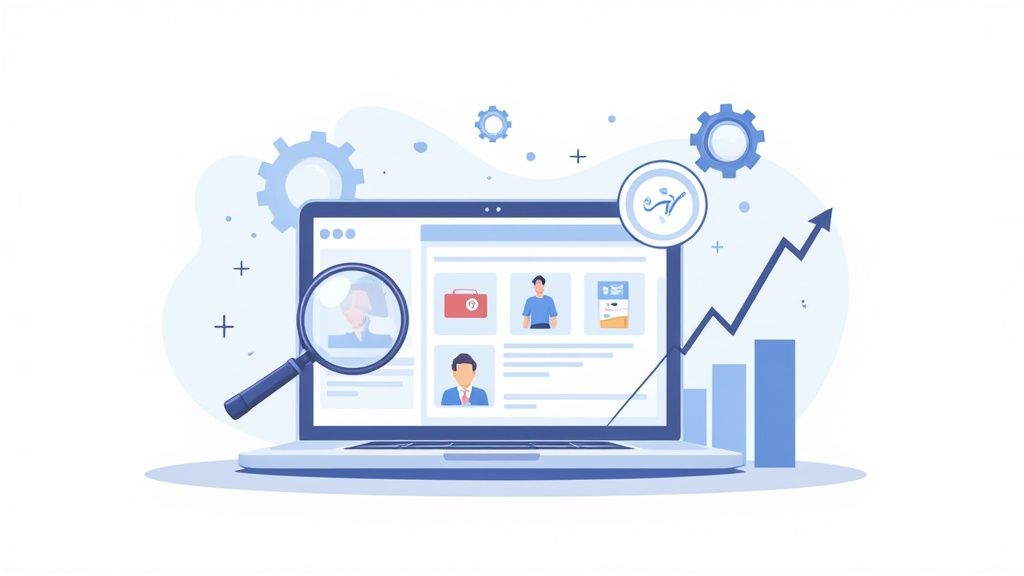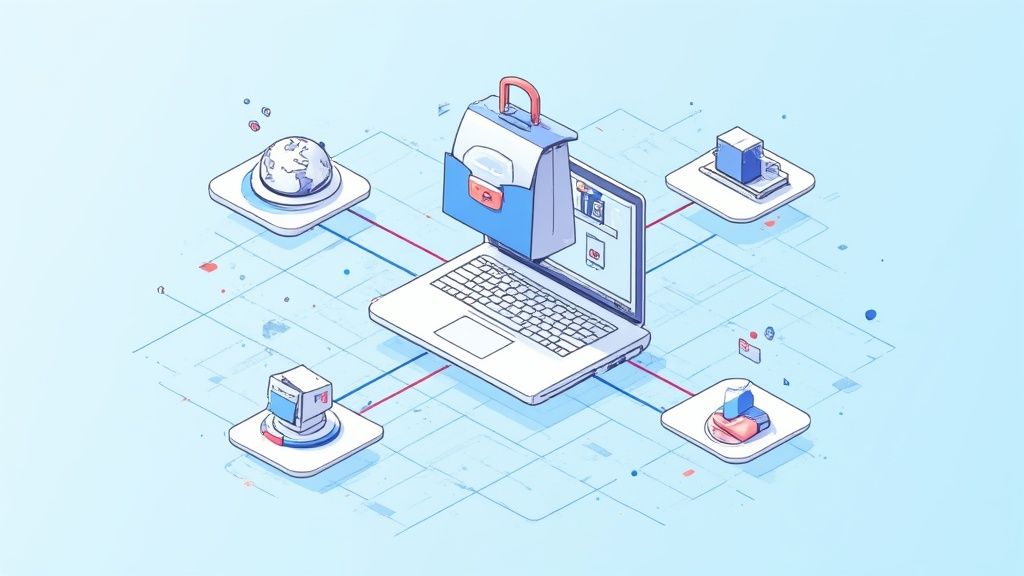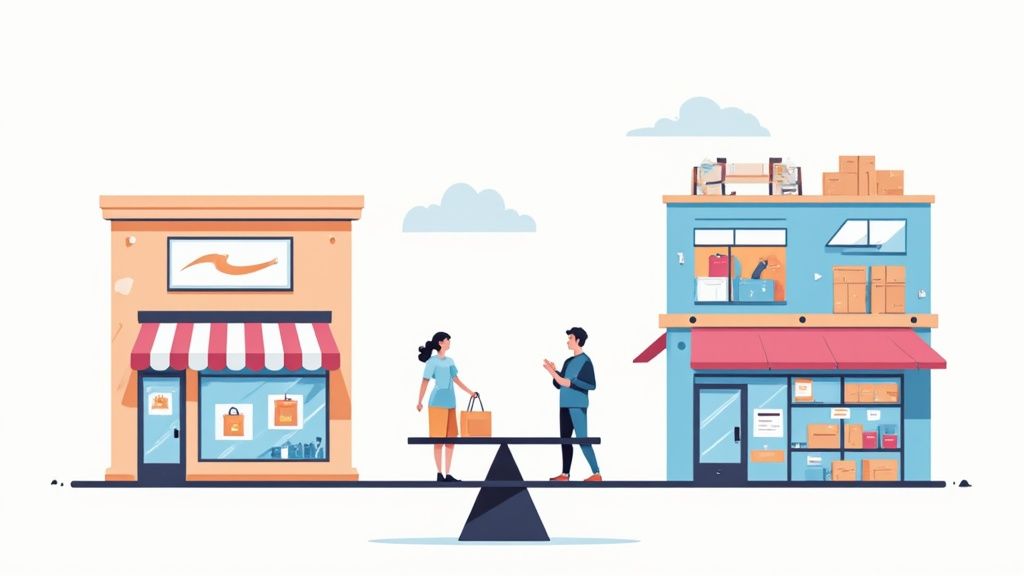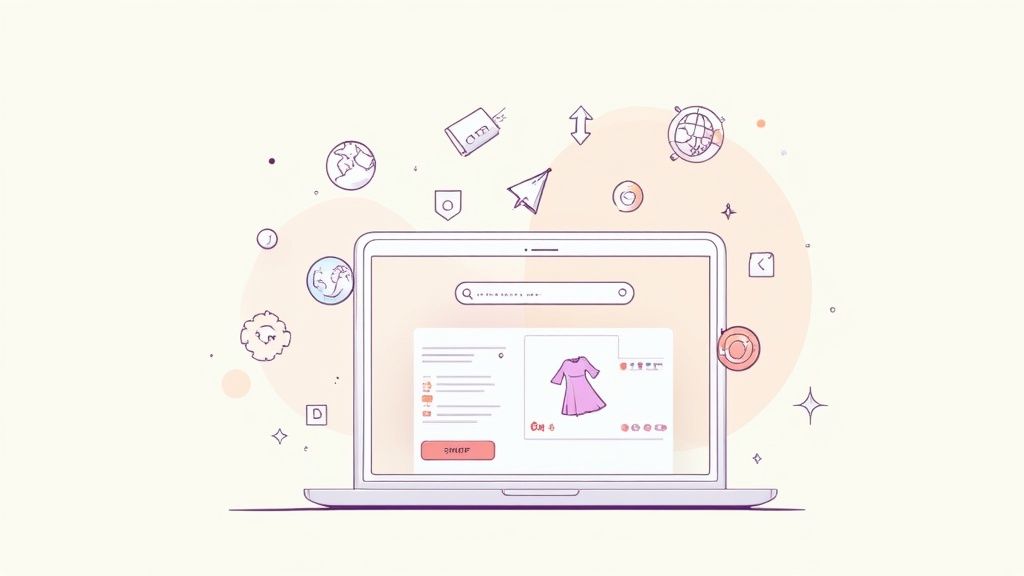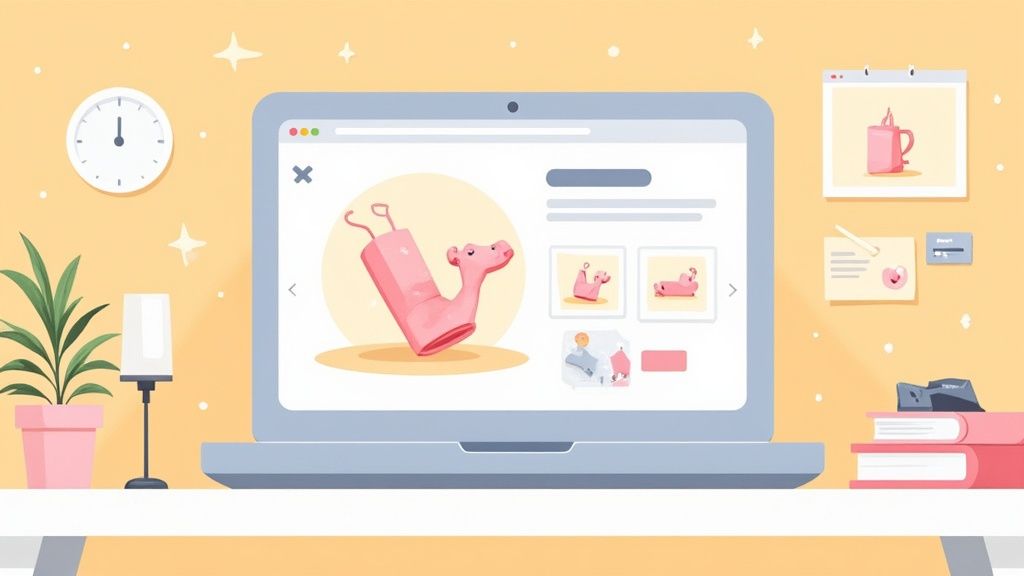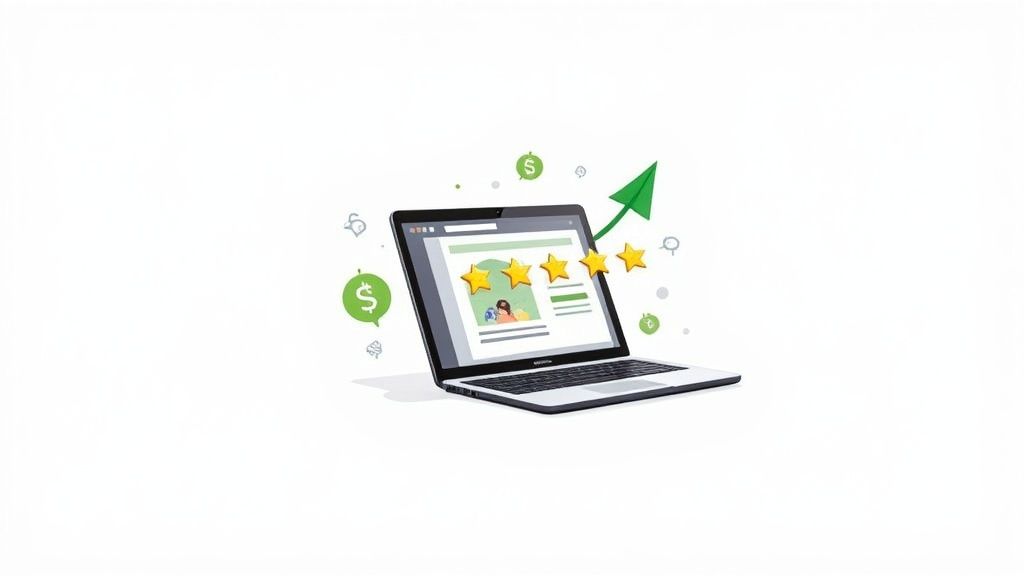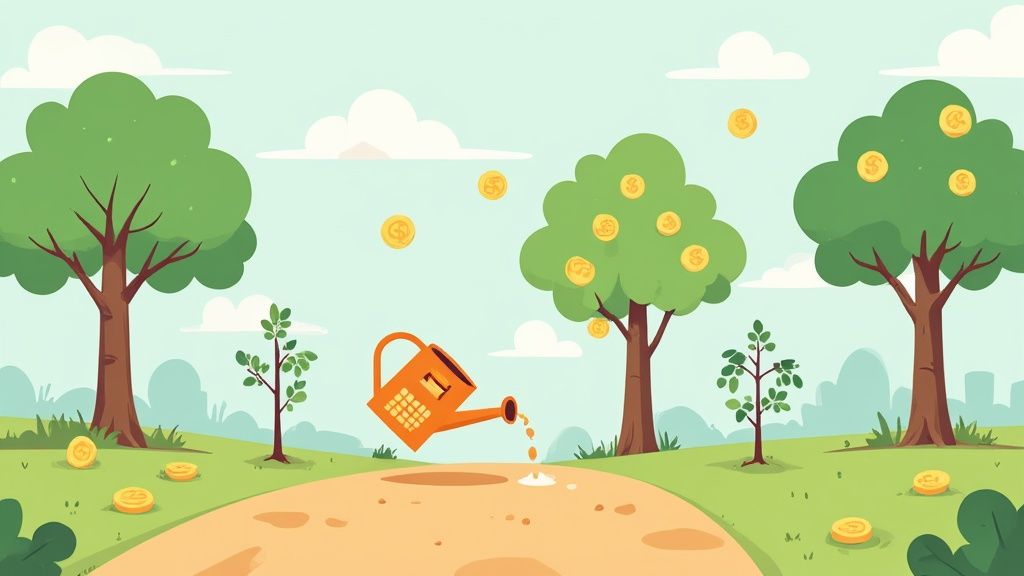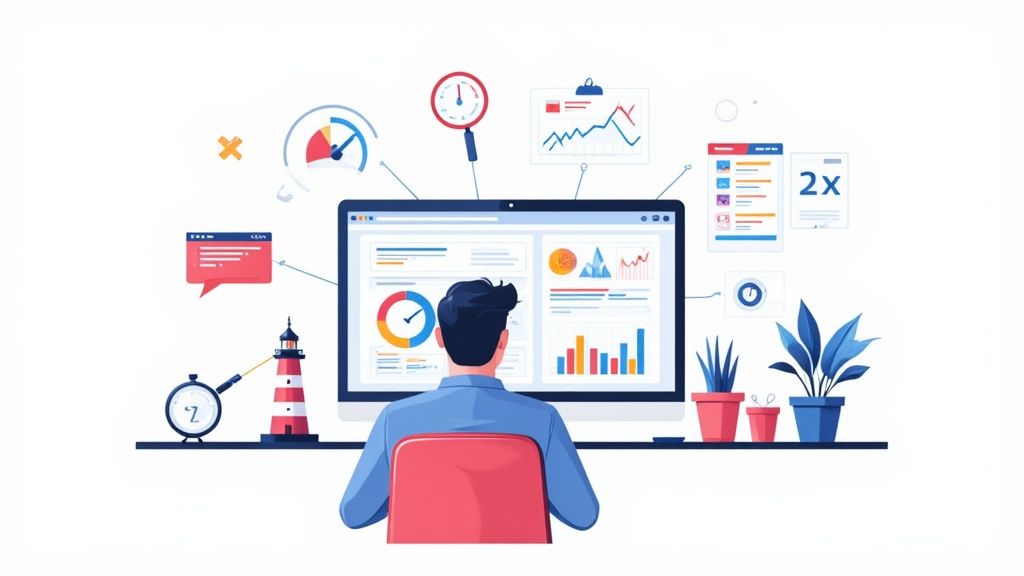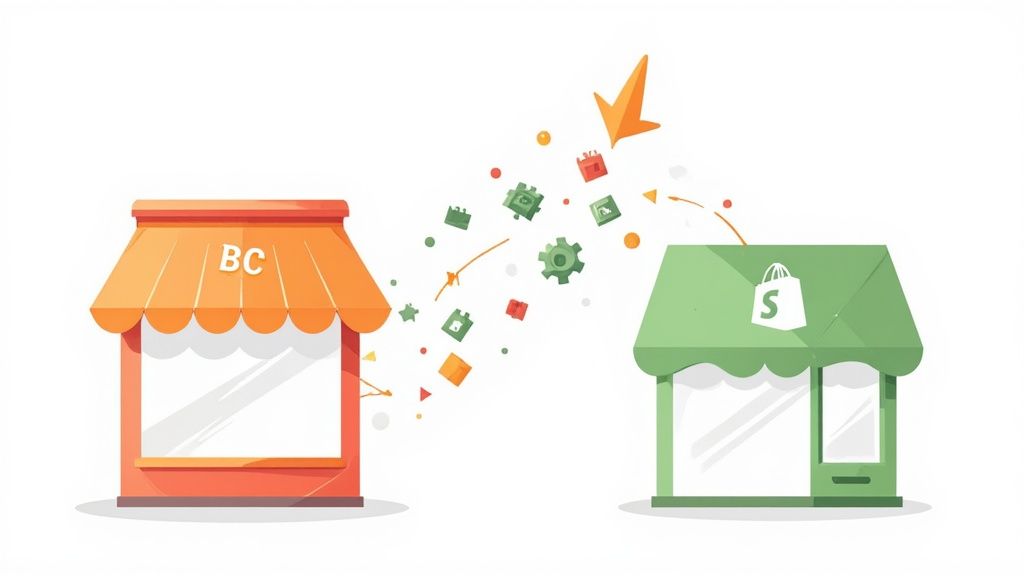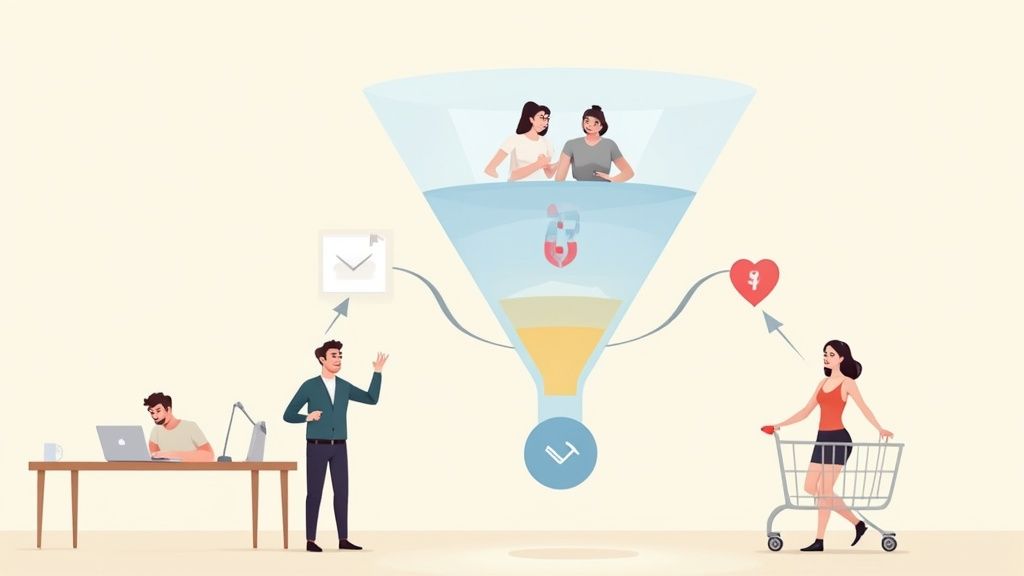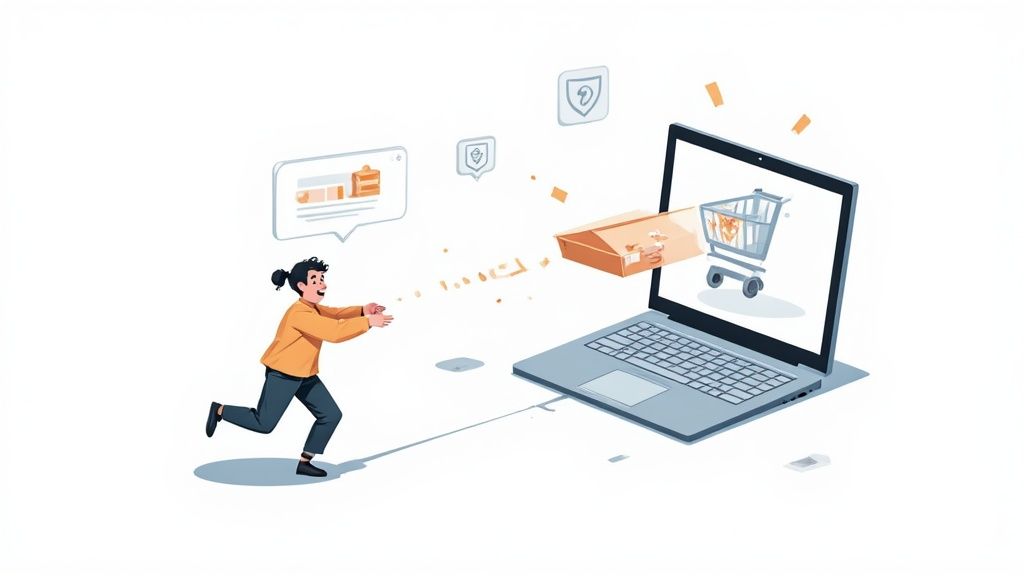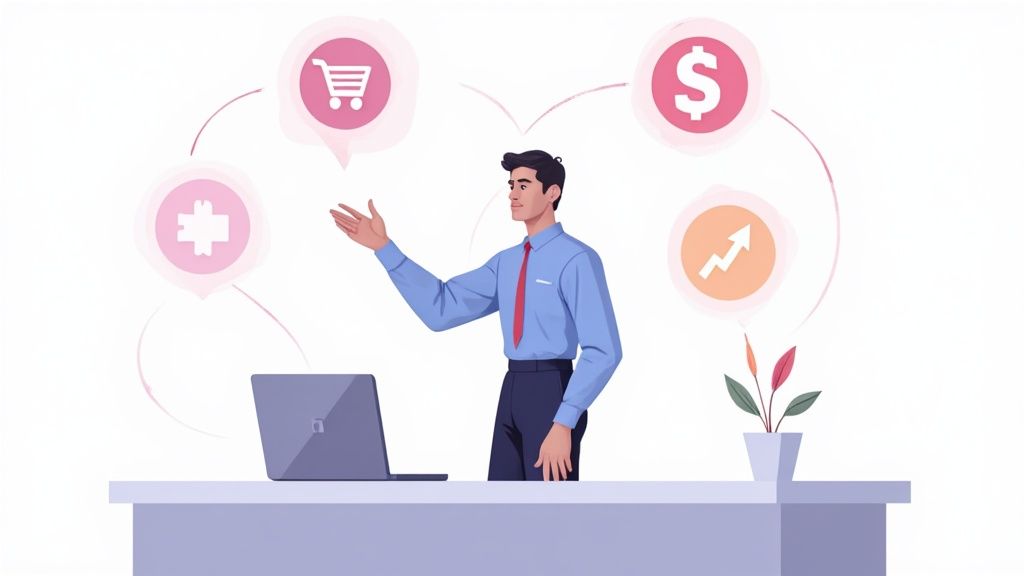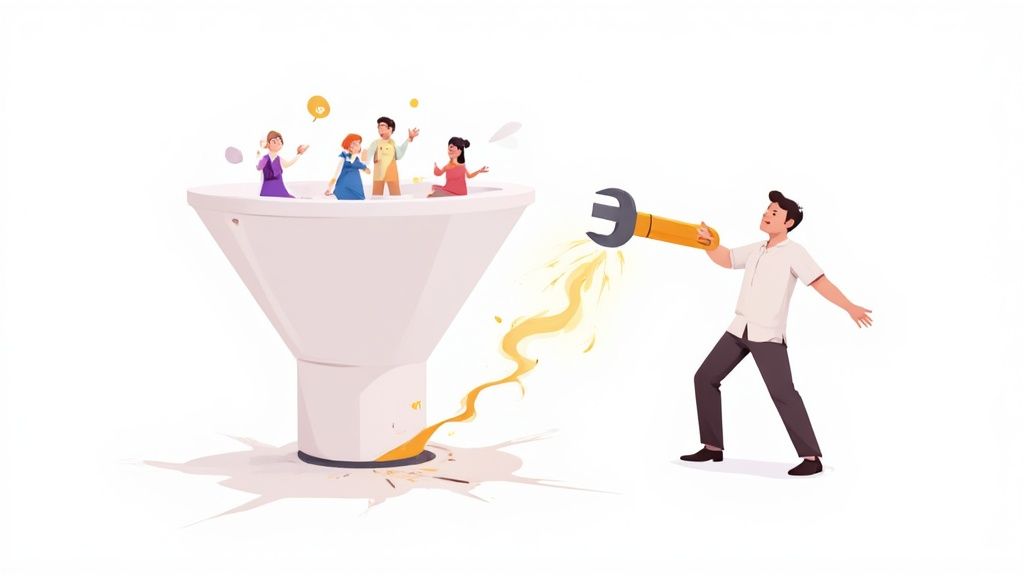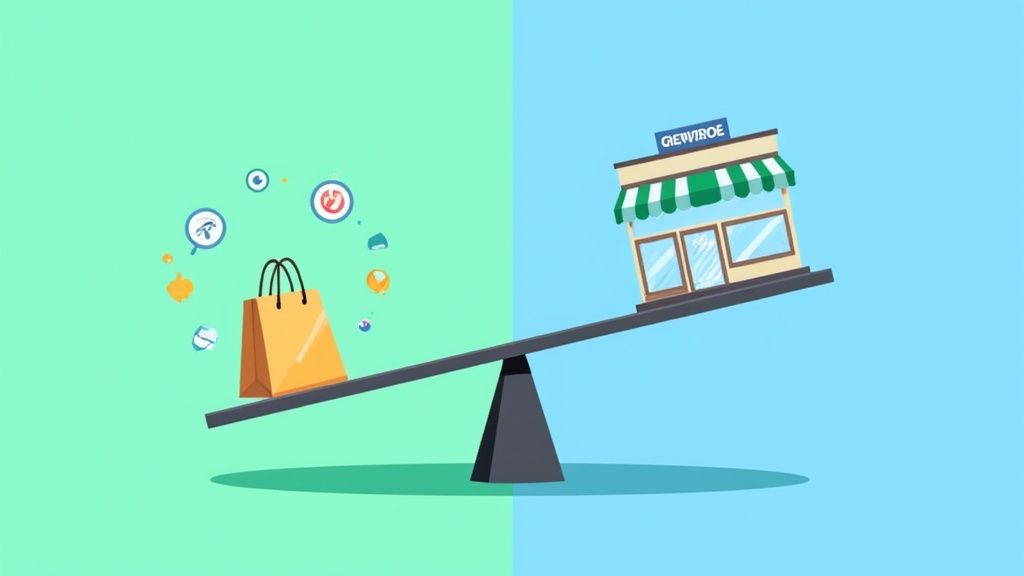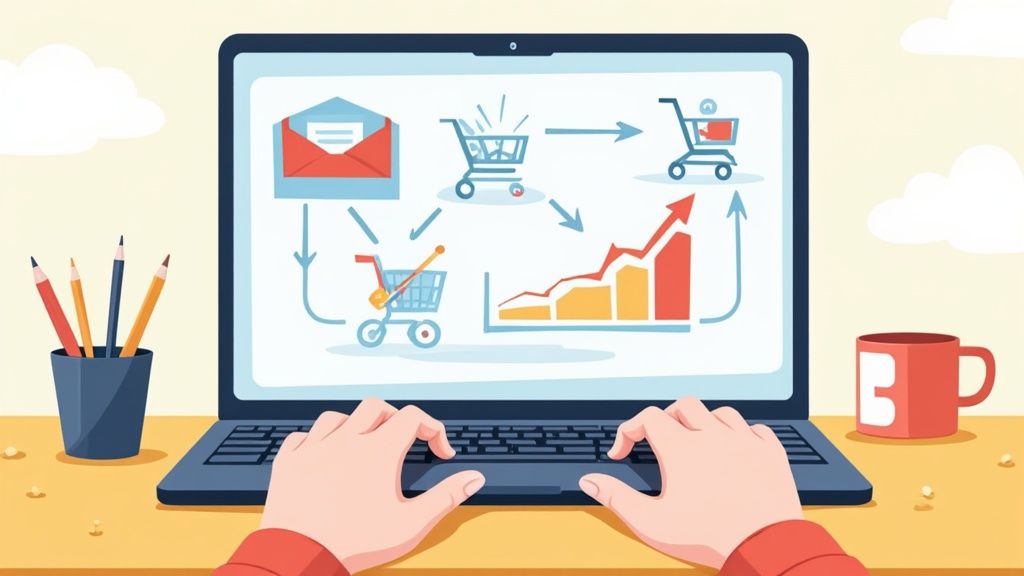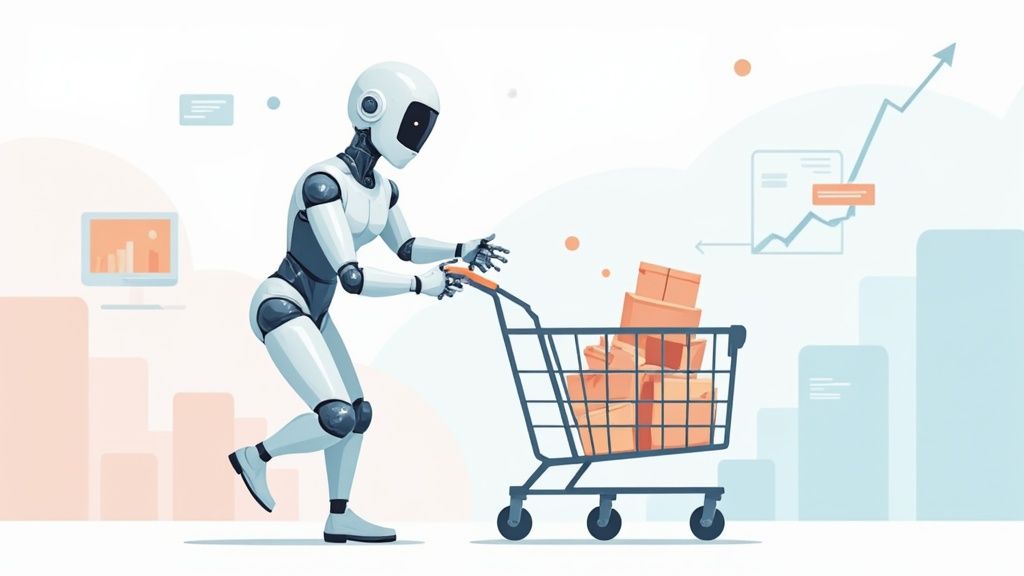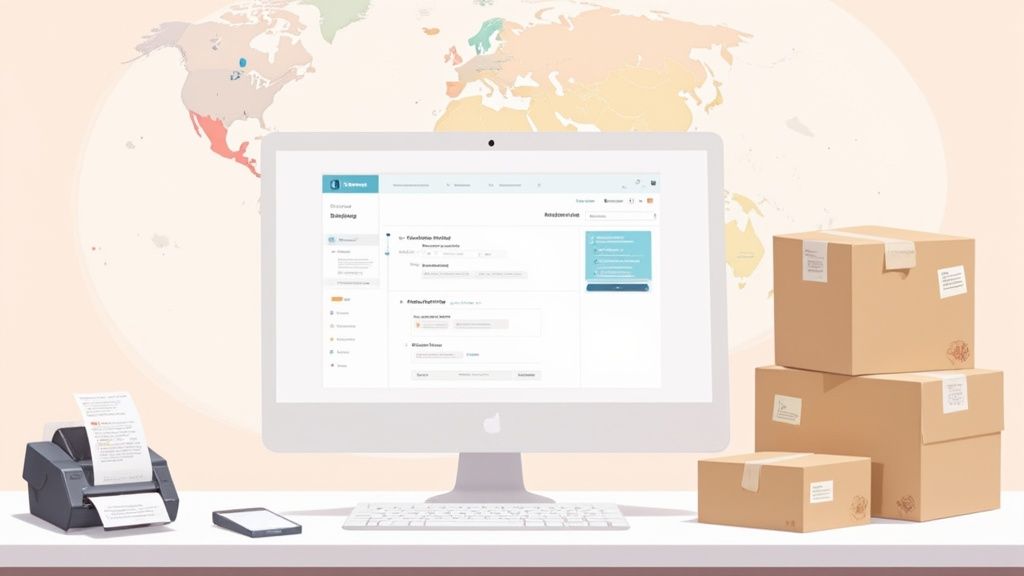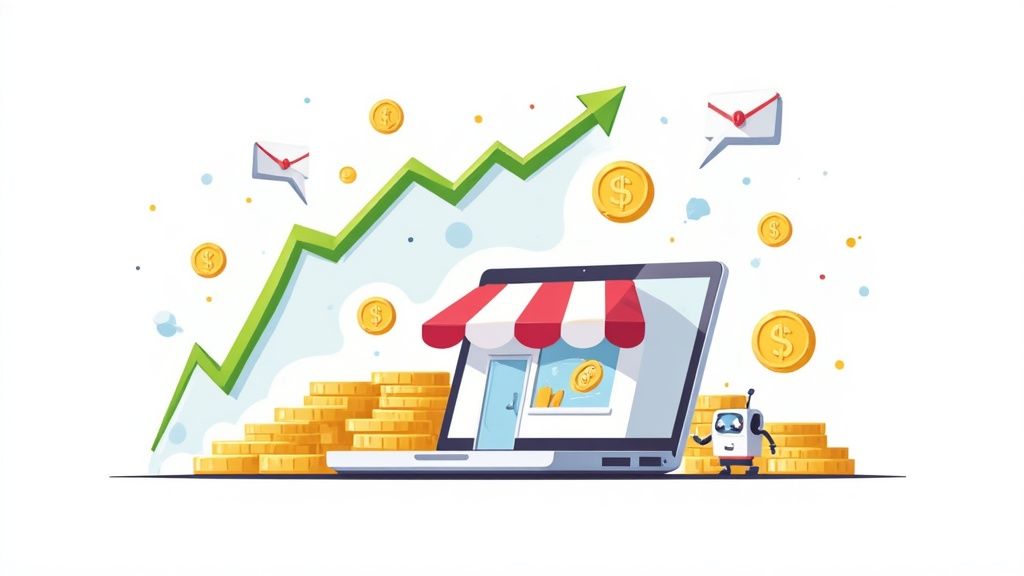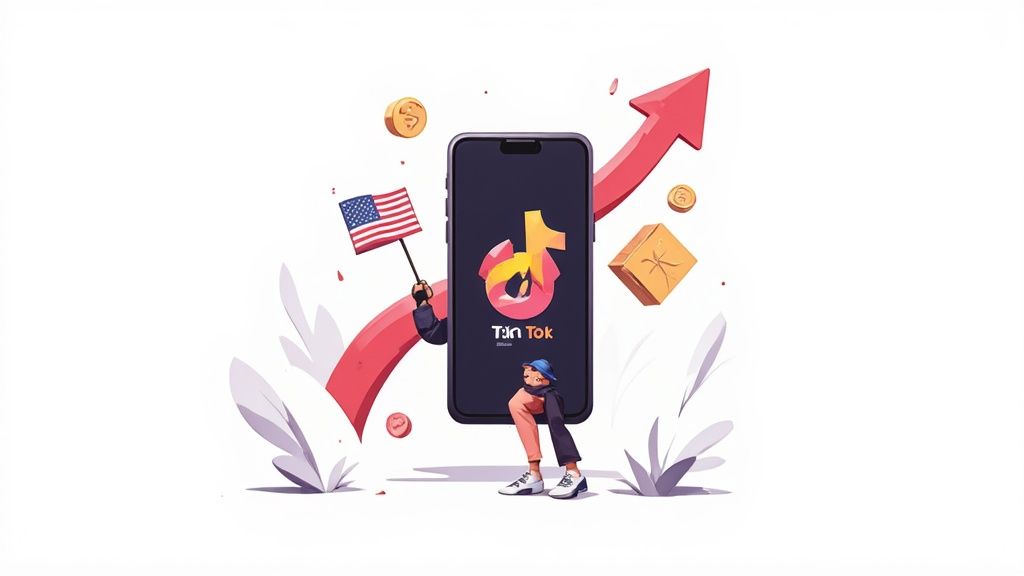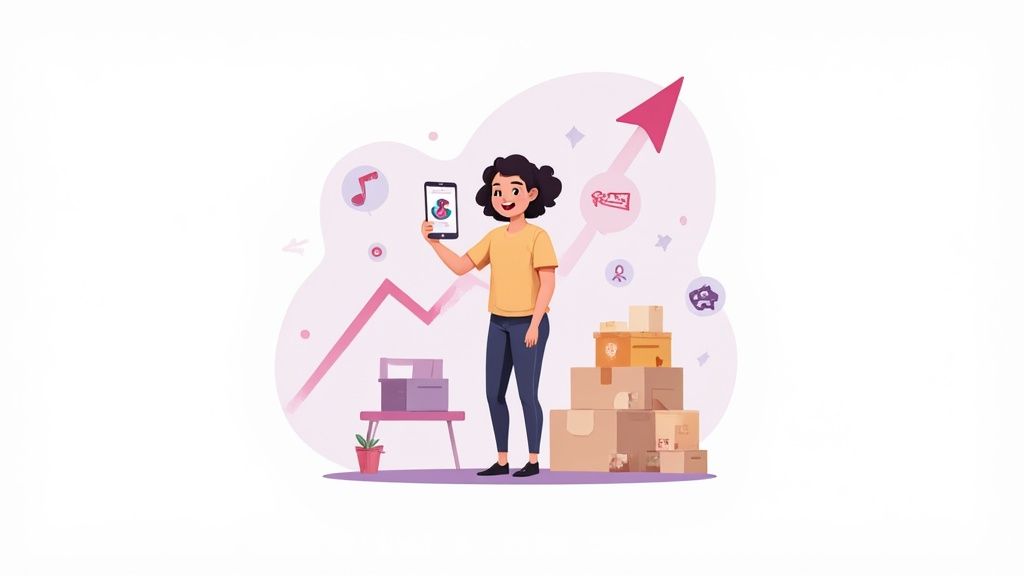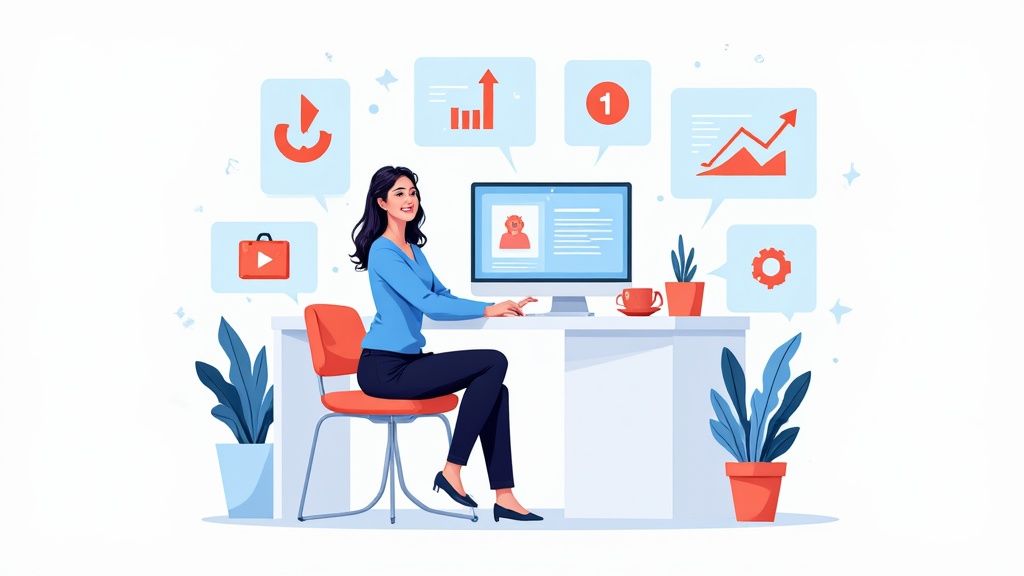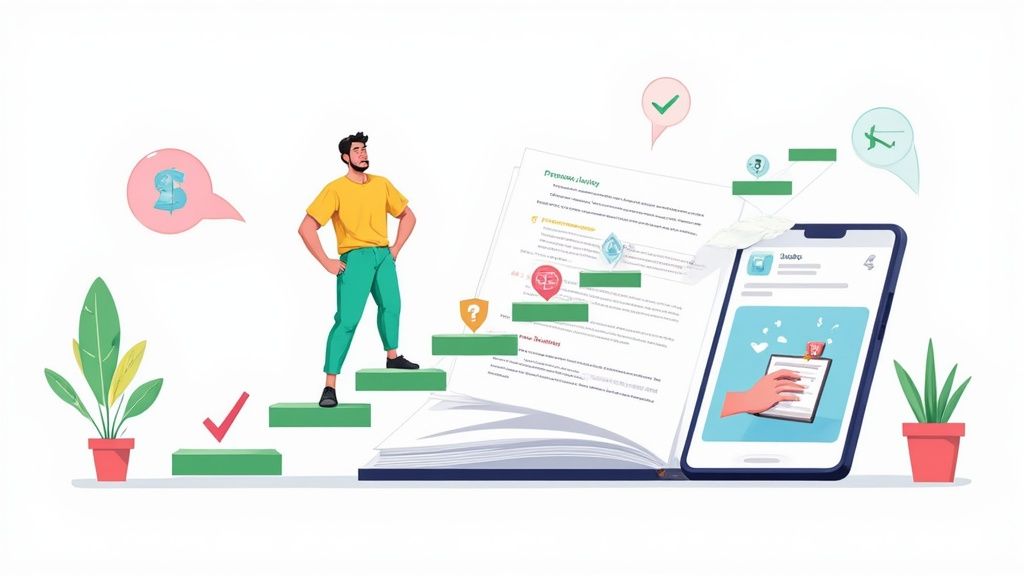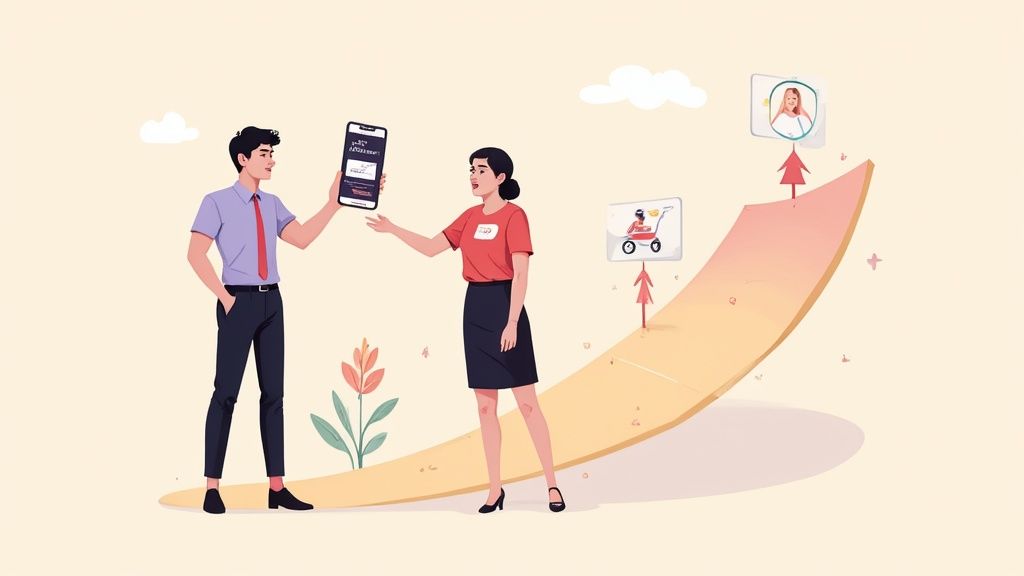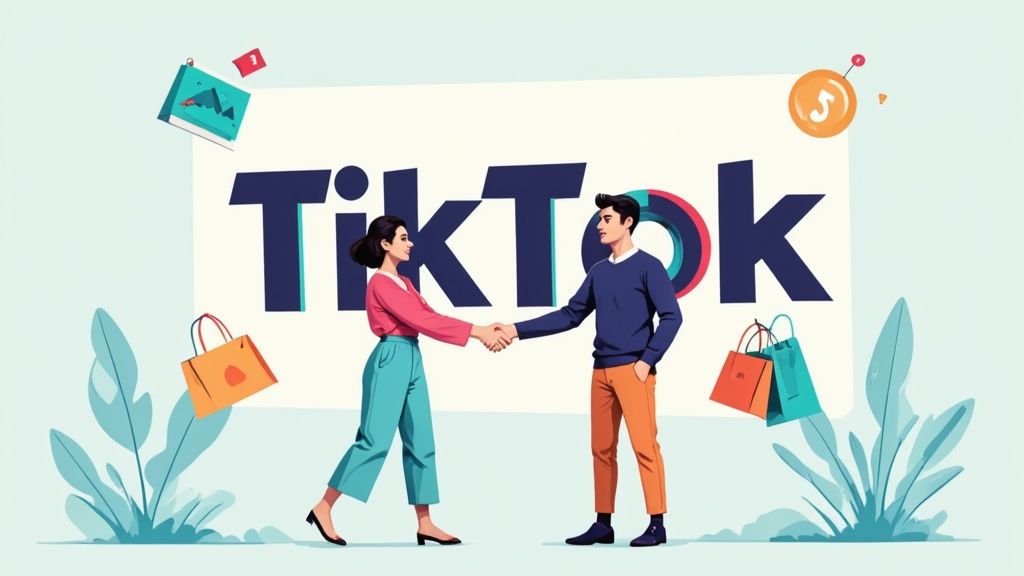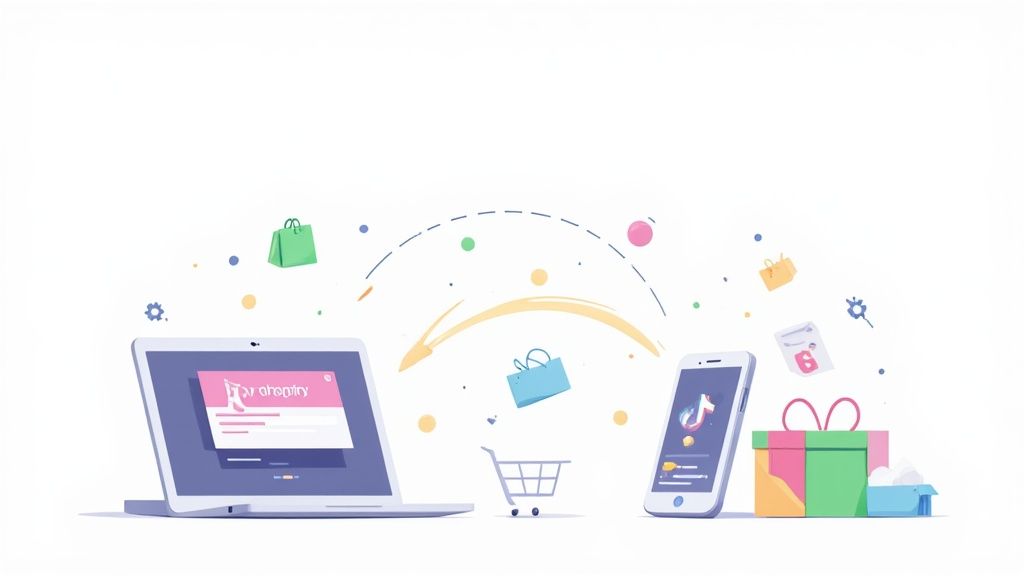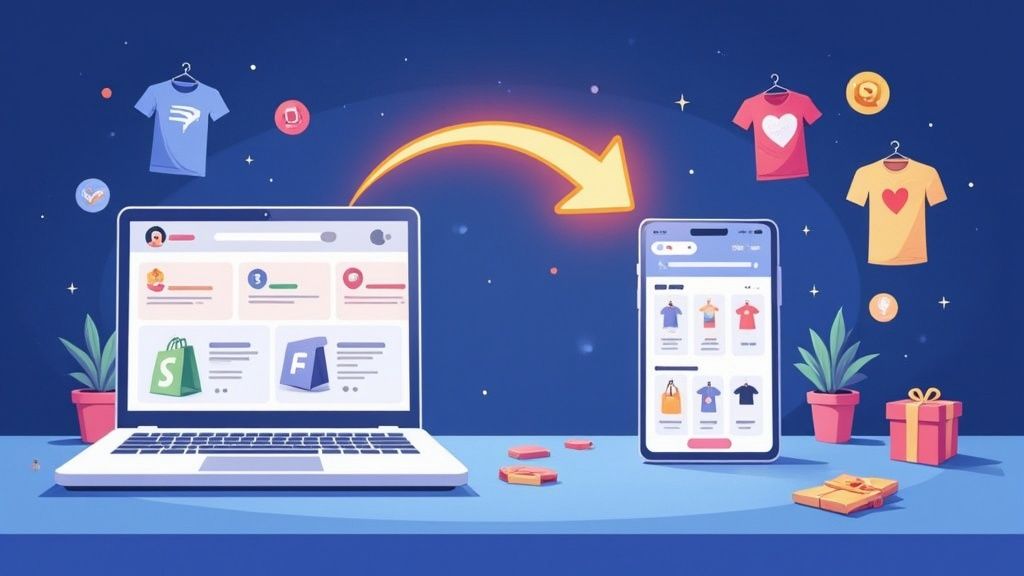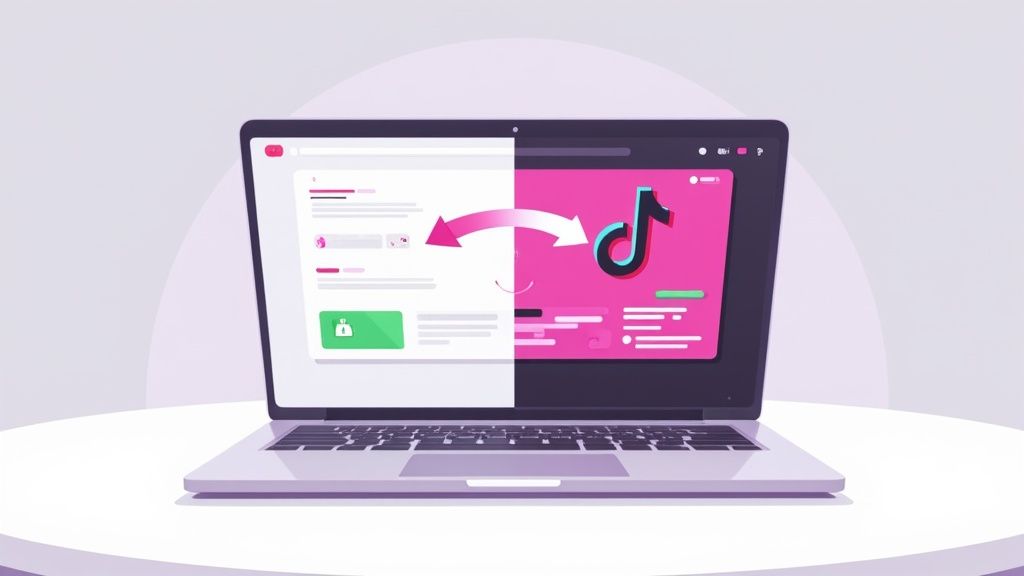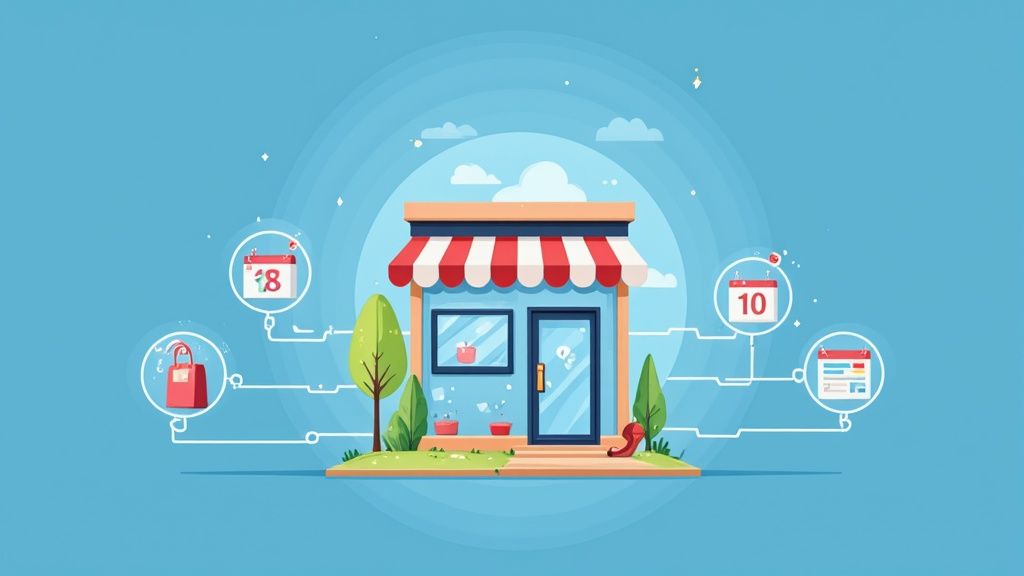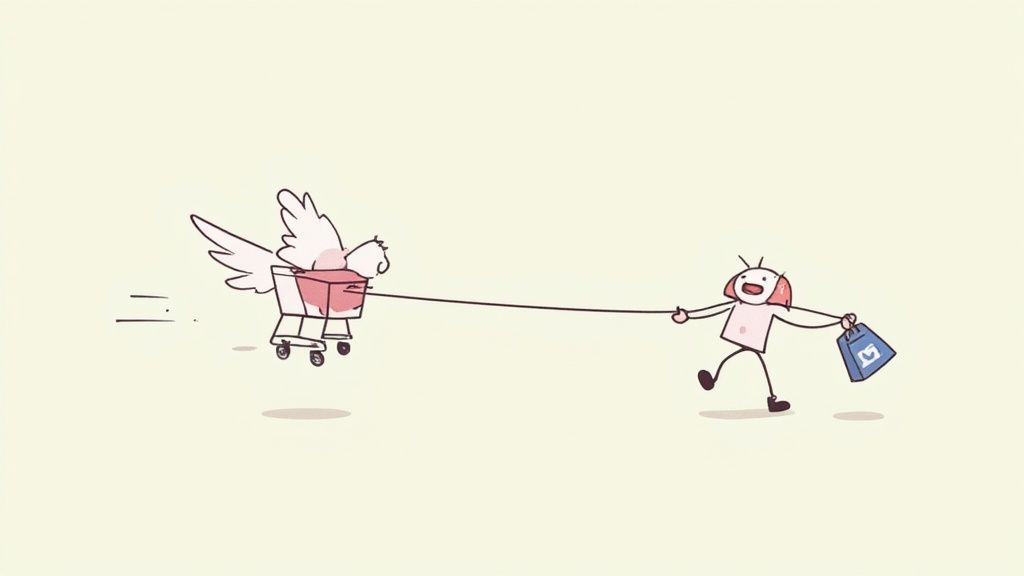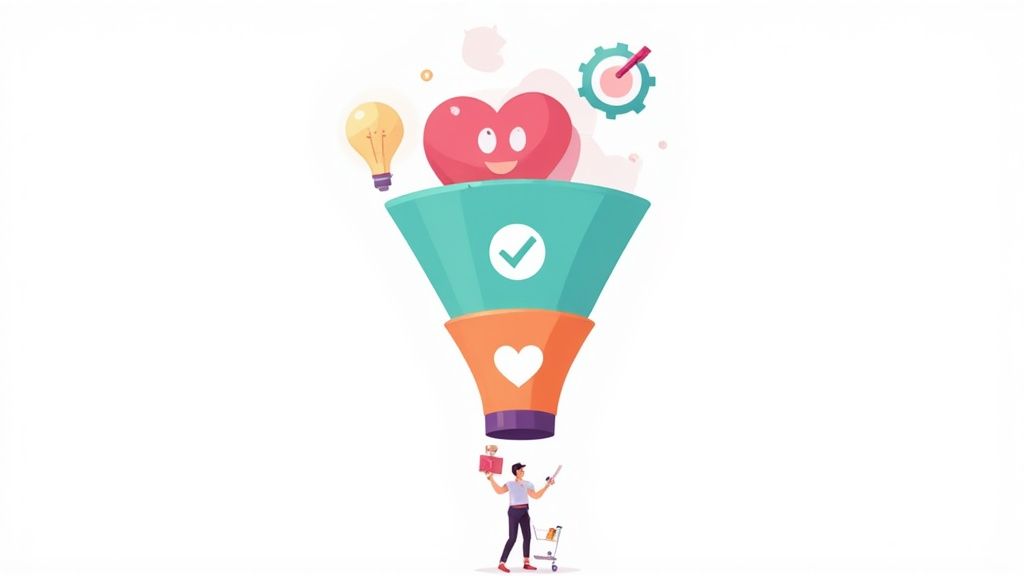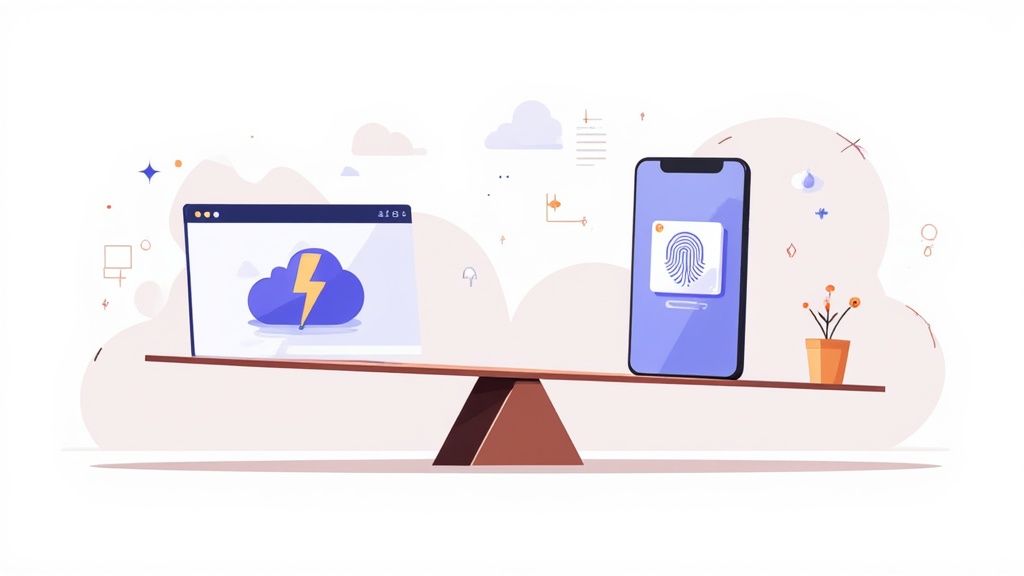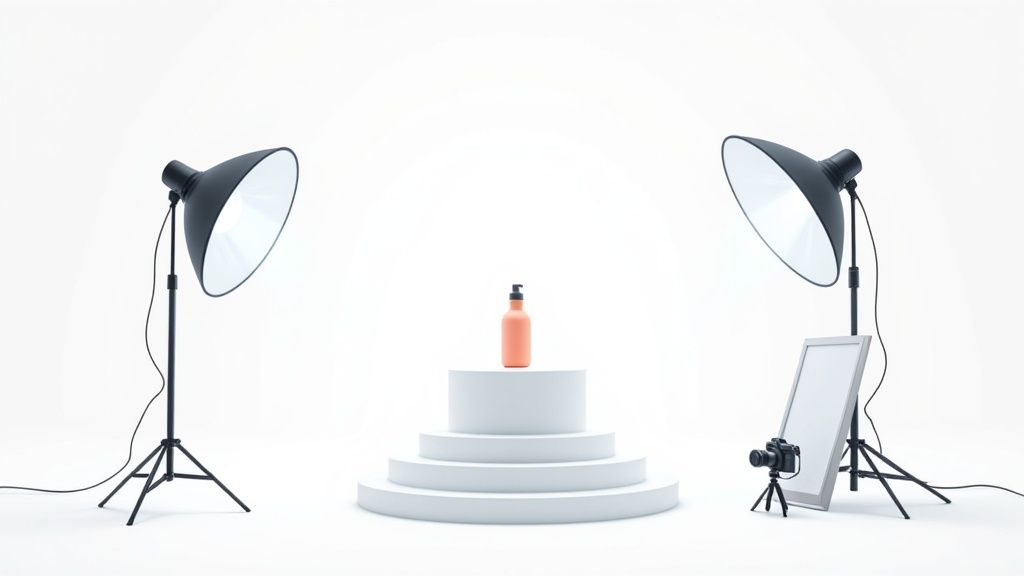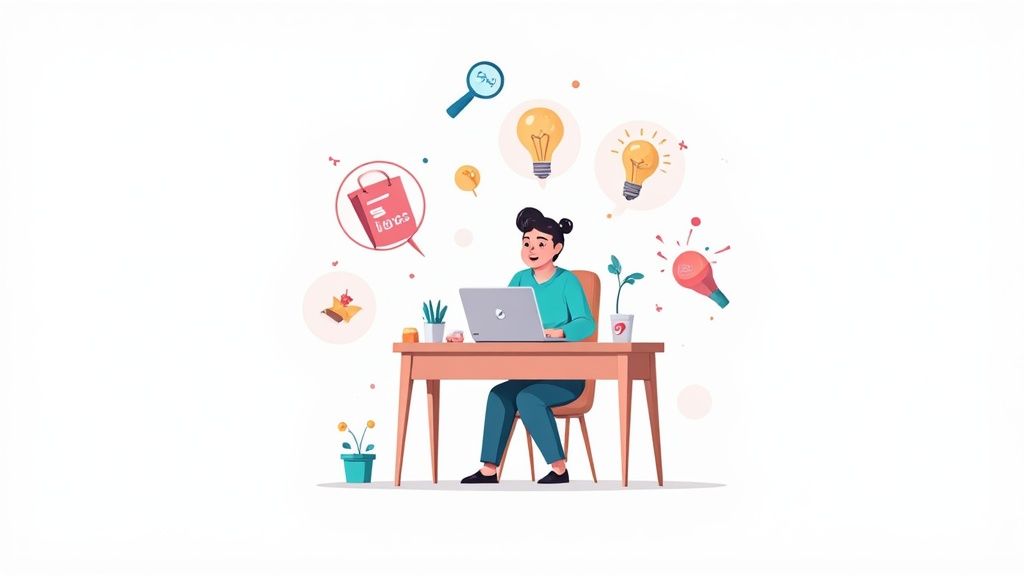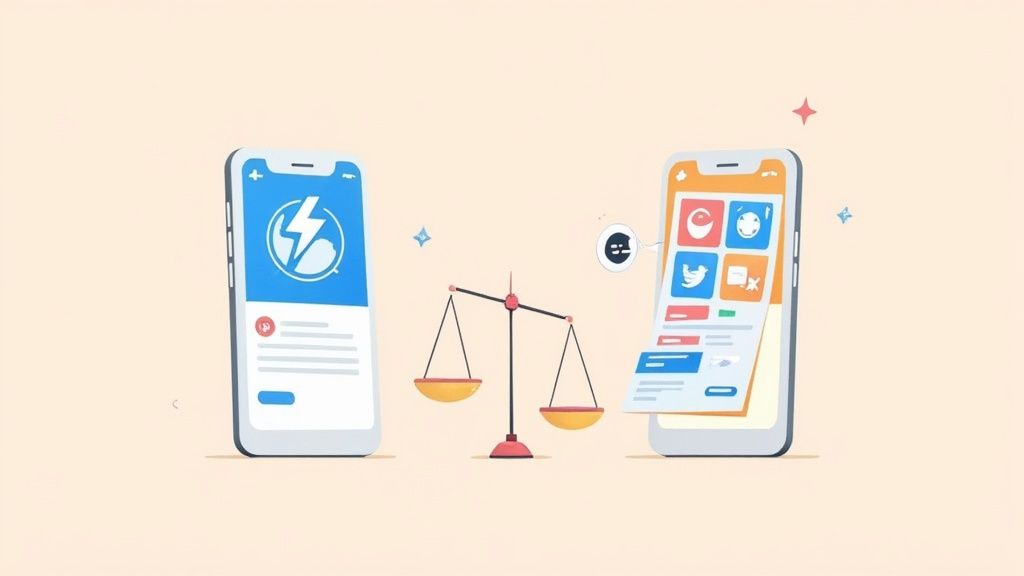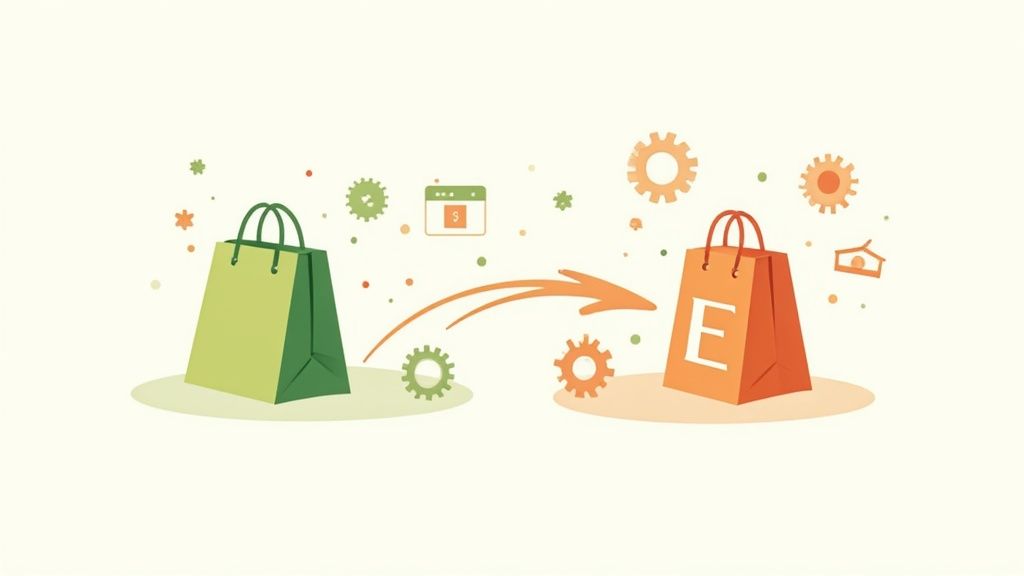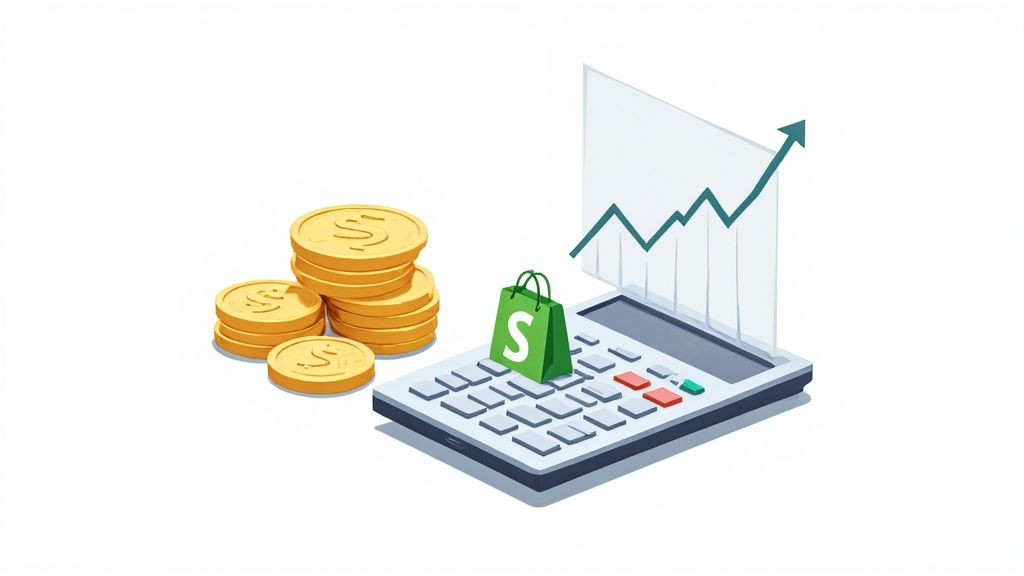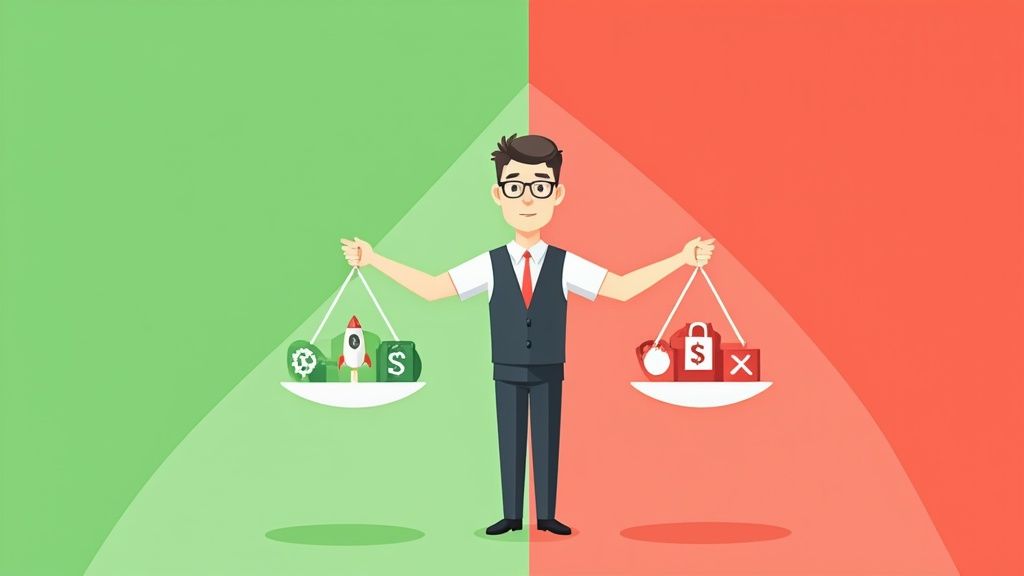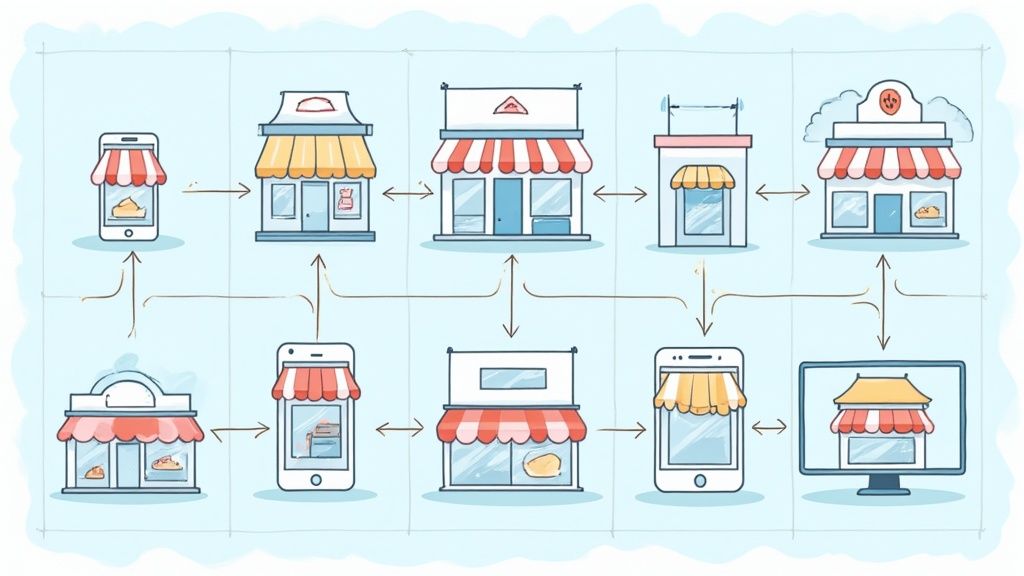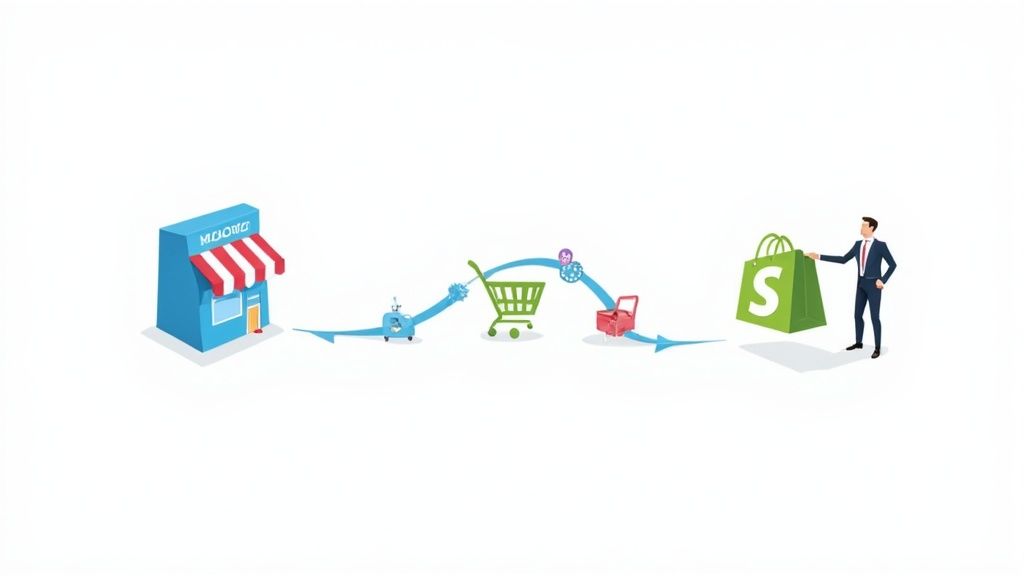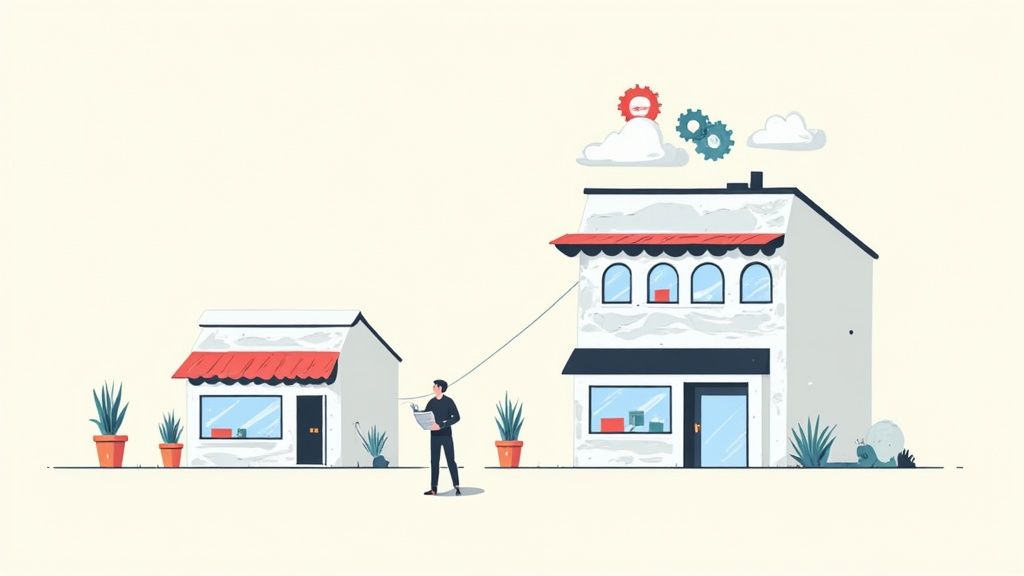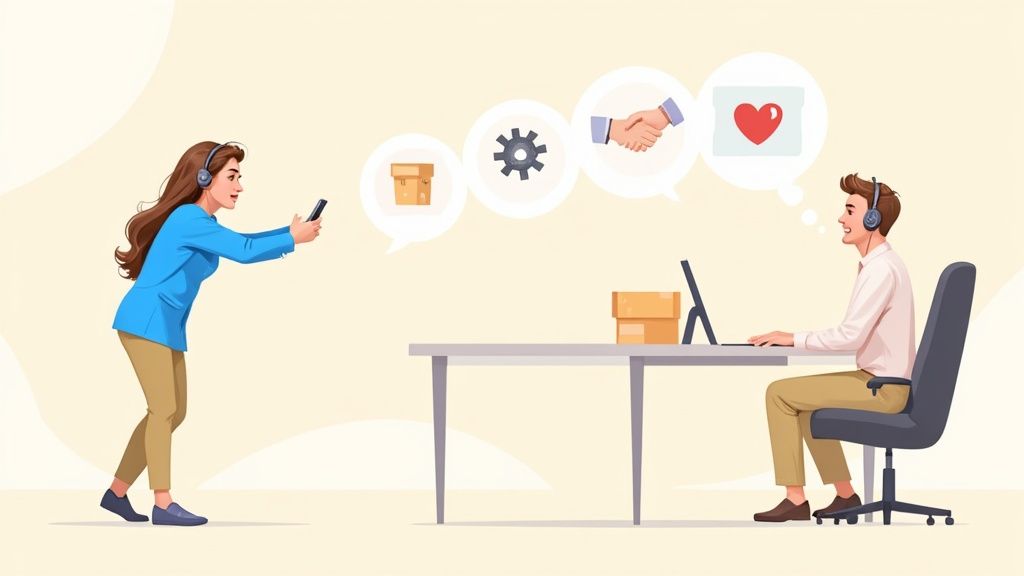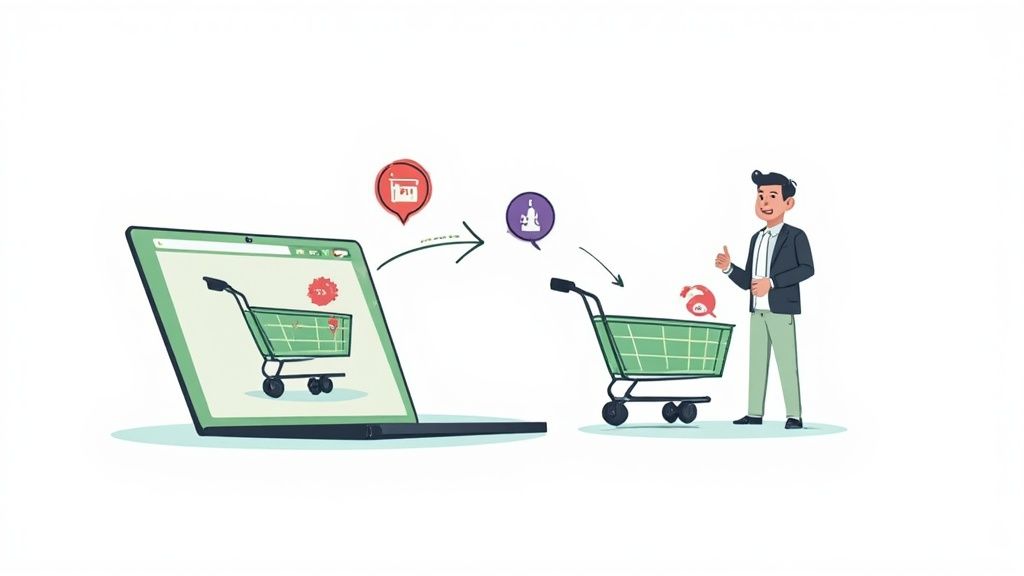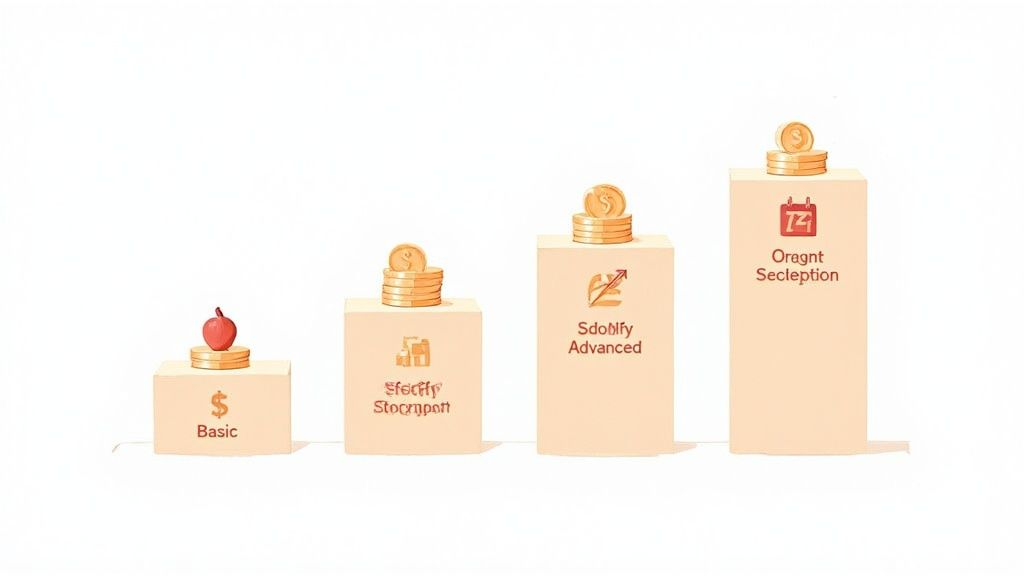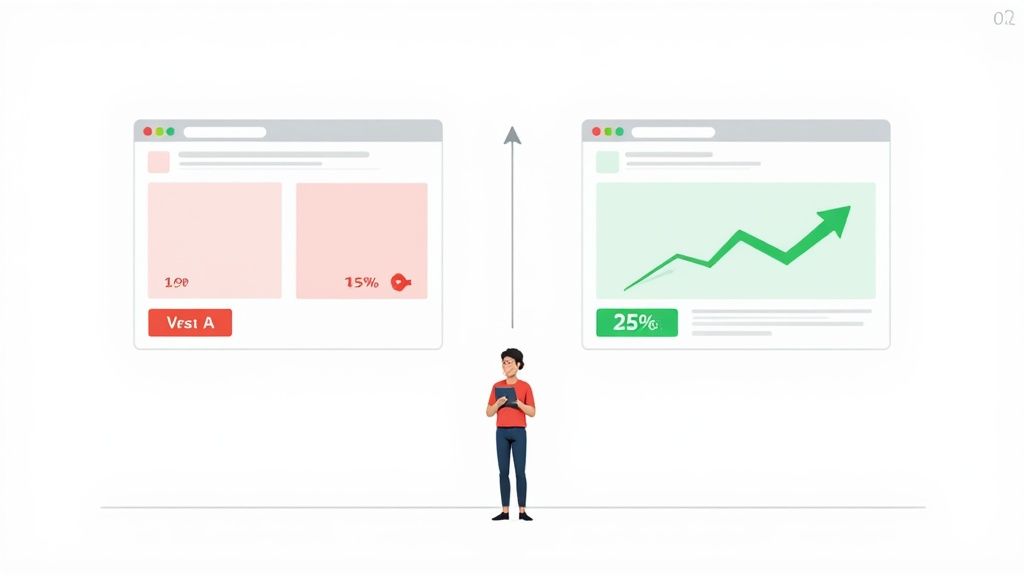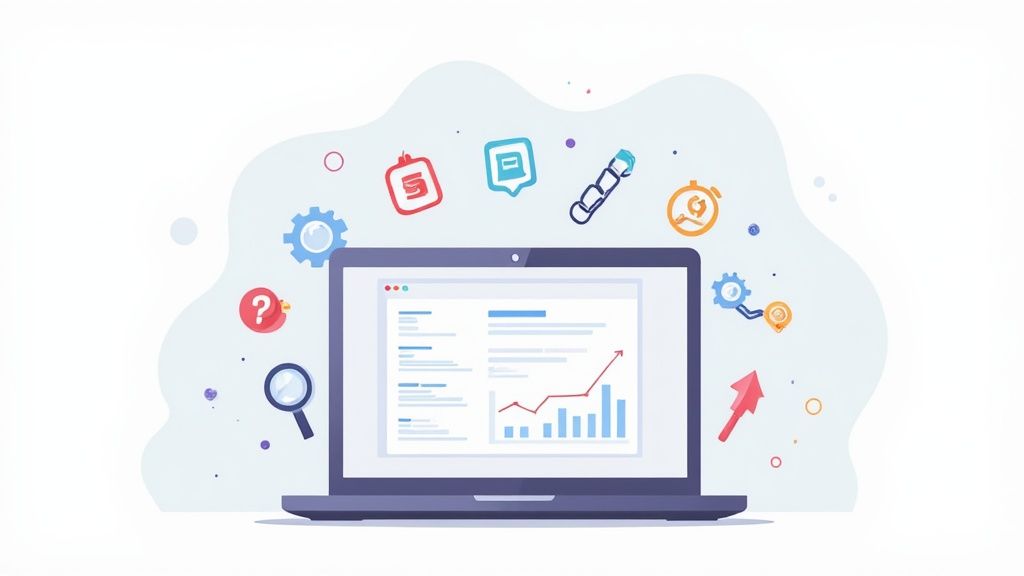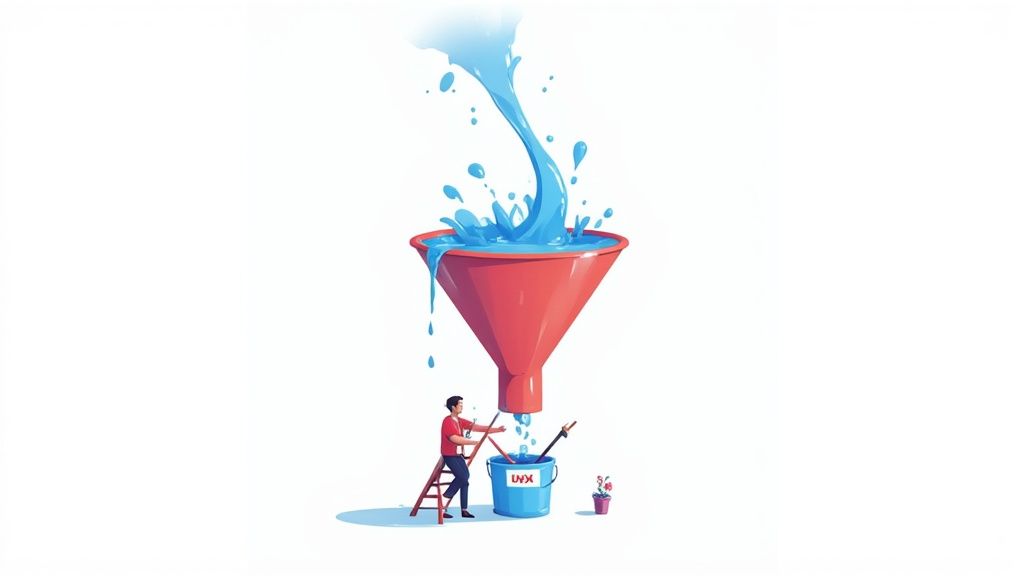
Here's the simple conversion rate optimisation definition: It's the systematic process of improving your website to get more visitors to take a desired action, like making a purchase. Instead of just getting more traffic, you get more value from the traffic you already have.
What Is Conversion Rate Optimisation in Plain English

Let's cut through the jargon. Imagine your eCommerce store is a real, brick-and-mortar shop on the high street. All the effort you put into SEO and advertising is like running TV commercials and putting up giant billboards to get people to walk through your front door. It’s absolutely vital for attracting potential customers.
But what happens once they’re inside? That’s where Conversion Rate Optimisation (CRO) kicks in.
CRO is everything you do to turn a window shopper into a paying customer. It’s about creating a fantastic experience once they're in your store—designing clear aisles, putting up helpful signage, having a friendly checkout assistant, and making sure the credit card machine works flawlessly.
The Leaky Bucket Analogy
One of the best ways to grasp CRO is with the "leaky bucket" analogy. Think of your website traffic as water you're pouring into a bucket. If that bucket has holes—like a confusing checkout process, slow-loading pages, or vague product descriptions—you’re going to lose water no matter how much you pour in.
You really only have two choices:
- Keep pouring more water in: This is the equivalent of cranking up your ad spend to get more traffic, just hoping that some of it manages to stay in the bucket. It's expensive and inefficient.
- Fix the holes: This is CRO. You methodically find and patch the leaks to hold onto more of the water you already have.
By fixing those holes, you convert more of your existing visitors into customers, all without having to pour more money into marketing. This is how you build a more efficient, profitable, and sustainable business.
A Systematic and Data-Driven Process
The key part of any good conversion rate optimisation definition is that it's a systematic process. This isn't about guesswork or randomly changing button colours because you saw a competitor do it. It’s a disciplined approach that relies on hard data and a deep understanding of customer behaviour to make smart improvements.
CRO is a structured approach to understanding why users aren't converting and then testing data-backed solutions to fix those issues. It transforms assumptions into certainties.
To give you a quick summary of what CRO really entails, let’s break down its core components.
CRO at a Glance Key Components
This process makes your marketing spend work harder and delivers sustainable results over the long term.
At its core, conversion rate optimisation is the methodical process of improving the percentage of visitors who complete a goal. The calculation itself is pretty simple: (Total Conversions / Total Visitors) × 100. For example, if your Shopify store gets 2,000 visitors and makes 100 sales, your conversion rate is a healthy 5%. You can dive deeper into CRO calculations and metrics with tools like Triple Whale.
The entire process involves watching how users move through your site, forming an educated guess (a hypothesis) about what could be improved, and then running a controlled test to see if you were right. It’s these small, validated changes that stack up to create significant wins over time.
Why CRO Is a Growth Engine for Ecommerce
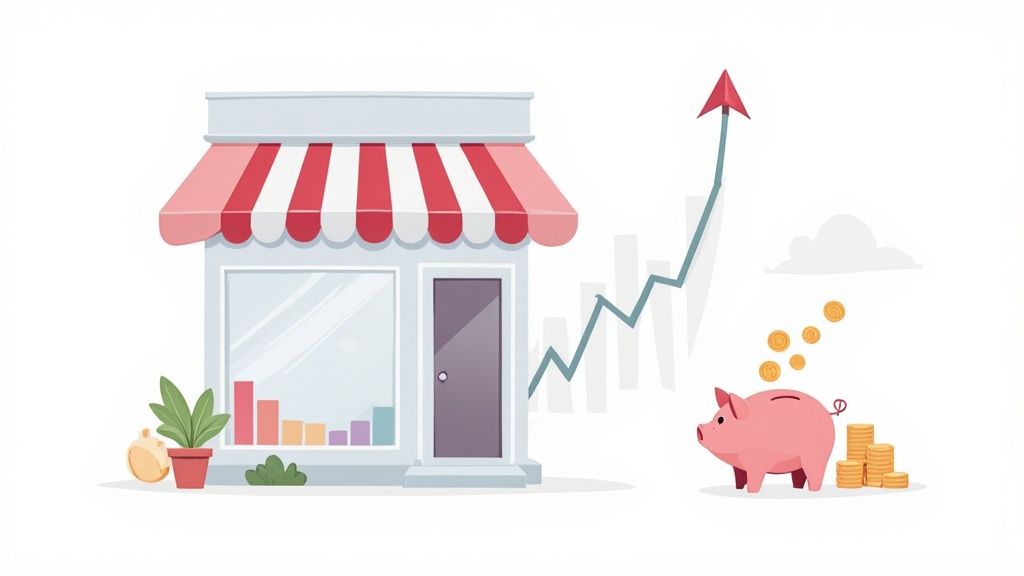
Knowing the conversion rate optimisation definition is a good start, but what really matters is connecting it to your bottom line. For any e-commerce business, CRO isn't just another marketing tactic; it’s one of the most powerful levers you can pull for profitable, sustainable growth.
So many brands fall into the trap of just pouring more and more money into ads to chase sales. While getting people to your site is obviously crucial, a CRO-first mindset is about maximizing the value of every single visitor you already have. It makes your existing marketing spend work that much harder.
This approach has a massive impact on two of the most critical metrics in e-commerce: Customer Acquisition Cost (CAC) and Customer Lifetime Value (LTV). By improving your conversion rate, you’re naturally lowering how much it costs to win over each new customer. And by creating a smoother, more intuitive user experience, you encourage people to come back and buy again, which directly boosts LTV.
The Real-World Impact on Revenue
Let's break it down with a simple scenario for a Shopify store. Imagine your store gets 20,000 visitors a month, with an average order value (AOV) of $75. Your current conversion rate is sitting at a respectable 1.5%.
- Monthly Revenue: 20,000 visitors x 1.5% conversion rate x $75 AOV = $22,500
Now, what happens if you use CRO to nudge that conversion rate up to just 2.0%? The traffic and AOV stay exactly the same.
- New Monthly Revenue: 20,000 visitors x 2.0% conversion rate x $75 AOV = $30,000
That tiny-looking 0.5% improvement just put an extra $7,500 in your pocket for the month. That’s $90,000 a year, all without spending another cent on ads.
This example proves that CRO isn't just another business expense—it's a direct investment in your growth. It’s the engine that turns the traffic you already have into compounding revenue, making your business more resilient and profitable. For a deeper dive into making this work for you, check out these proven e-commerce CRO strategies.
The Metrics That Truly Matter in CRO
While your overall conversion rate is the headline number, mastering conversion rate optimisation is all about digging into the diagnostic metrics that tell the full story. Think of it like a doctor checking vital signs before making a diagnosis. These key performance indicators (KPIs) are your eCommerce store’s vital signs, revealing exactly where customers are dropping off and where your biggest opportunities are hiding.
Focusing only on the final sale is like watching the scoreboard of a game without seeing any of the plays. To win, you have to break down the individual moments that lead to a score.
Beyond the Primary Conversion Rate
To get the full picture, you have to look beyond a single number. For a detailed breakdown of how to calculate your main conversion rate, you can explore our complete guide on what a conversion rate is. Now, let’s get into the other metrics that give it critical context.
Here are the diagnostic metrics every Shopify store owner should be tracking:
- Average Order Value (AOV): This tells you exactly how much an average customer spends in one go. Pushing this number up with tactics like product bundling or smart upsells is a fantastic way to boost revenue without needing more traffic.
- Cart Abandonment Rate: This is the percentage of shoppers who add items to their cart but bail before paying. A high rate is a huge red flag, often pointing to friction in your checkout—think unexpected shipping costs or a clunky form.
- Bounce Rate: This is the percentage of visitors who land on a page and leave without clicking anything else. A high bounce rate could mean your ad copy doesn't match the landing page, or maybe the page is just too slow to load.
- Average Session Duration: This simply tracks how long visitors stick around on your site. Longer sessions usually mean they're engaged, while super short ones might suggest they're confused by the navigation or bored by the content.
Using Data to Pinpoint Problems
These metrics don’t exist in a vacuum; they work together to map out your customer's journey. For example, if you see a high bounce rate on a product page paired with a low average session duration, that’s a strong signal your product descriptions or images just aren't cutting it.
By analysing these supporting metrics, you shift from guessing what’s wrong to knowing exactly where to focus your optimisation efforts for the greatest impact.
It also helps to know how you stack up against the competition. Industry benchmarks add some much-needed context. For instance, in eCommerce, search traffic often converts best at around 3%, while social media tends to hover around 1%. Different niches also see different results; food and beverage stores average a 2.6% conversion rate, while apparel is a bit lower at 2.2%. Knowing where you stand helps you set realistic goals. You can find more details on these and other industry trends by checking out these conversion rate optimisation statistics.
Mastering the Core CRO Process
Conversion Rate Optimisation isn't about throwing random ideas at the wall to see what sticks. Far from it. It's a disciplined, almost scientific method for generating predictable growth. Think of it less like an art project and more like a structured lab experiment, where every single change is designed to prove or disprove an educated guess.
This repeatable cycle is what separates the pros from the amateurs. It gives you a clear framework that turns abstract ideas into a concrete process, making sure your improvements are driven by hard evidence, not just a gut feeling. Sticking to this method allows you to systematically hunt down and eliminate the friction points that are quietly killing your sales.
Research and Analysis
The first phase is all about putting on your detective hat. Before you can fix anything, you need to understand the problem inside and out. This means gathering both quantitative data (the "what") and qualitative data (the "why") to get a 360-degree view of how people are actually using your site.
Here’s what that looks like in practice:
- Analytics Deep Dive: You'll dig into your store's analytics, looking for the digital crime scenes—pages with high drop-off rates, dismal engagement, or terrible conversion numbers. This tells you where the trouble is.
- Behavioural Tools: Using tools like heatmaps and session recordings, you get to be a fly on the wall, watching how real users click, scroll, and navigate your site. You'll see exactly where they get confused or frustrated.
- User Feedback: Sometimes the best way to find out what's wrong is just to ask. Surveys, polls, and even customer service logs can give you direct, unfiltered feedback from users in their own words.
Hypothesis Formulation
Once you’ve pinpointed a problem area, it's time to form a hypothesis. A hypothesis isn't complicated; it's just a clear, testable statement that proposes a fix and predicts what will happen. It follows a simple but powerful structure: "If I change [X], then [Y] will happen, because [Z]."
For instance, a solid hypothesis might sound like this: "If we add customer testimonials directly below the 'Add to Cart' button on our product pages, then our add-to-cart rate will increase, because it will build trust and dial down purchase anxiety at the most critical moment."
See how that works? It forces you to connect a specific action to a measurable outcome, all backed by a bit of customer psychology.
A well-formed hypothesis is the bedrock of any successful CRO test. It makes sure your experiments are strategic and aimed at solving a real user problem, not just changing things for the sake of it.
This flow chart shows how key diagnostic metrics—like bounce rate, cart abandonment, and average order value—are all connected, helping you spot the friction in your customer's journey.

It's a great visual for understanding how a high bounce rate means fewer people ever make it to the cart, which has a direct knock-on effect on your potential AOV.
Prioritisation, Testing, and Learning
Okay, so you've got a handful of solid hypotheses. Which one do you test first? You can't do everything at once. Effective prioritisation is about focusing your time and money on the ideas that have the best shot at delivering a real impact. Frameworks like PIE (Potential, Importance, Ease) are great for scoring each idea objectively instead of just going with your favourite.
Once you have a winner, it’s time to test. The go-to method here is A/B testing. You simply show the original version of your page (the control) to one group of visitors and your new version (the variation) to another. The goal is to see which one performs better against your target metric. If you want to go deeper, check out our guide on A/B testing best practices.
Finally, you crunch the numbers and see if your hypothesis was right. But here’s the best part: whether the test is a massive win or a total flop, you’ve learned something valuable about your customers. That new insight then feeds right back into the research phase, creating a continuous loop of improvement that steadily lifts your conversion rate over time.
Proven CRO Tactics You Can Implement Today

Understanding the CRO process is one thing, but the real fun begins when you start putting it into practice. This is where theory turns into tangible results. It’s about implementing proven tactics that smooth out the specific friction points your customers are hitting. These strategies are battle-tested improvements that consistently give eCommerce stores a lift.
Instead of drowning you in a giant list of possibilities, let's focus on a few high-impact areas where you can start seeing improvements right away. From your homepage to the final checkout button, these tactics are practical, effective, and a great place to begin your optimisation journey.
Sharpen Your Calls to Action
Your Call-to-Action (CTA) buttons are probably the single most important clickable elements on your entire website. They're the final hurdle before a conversion. Making them clear, compelling, and impossible to miss isn't just a good idea—it's essential.
- Use Action-Oriented Language: Ditch passive words like "Submit." Instead, use benefit-driven phrases that tell the user exactly what they're getting. Think "Get Your Free Quote" or "Start My Trial."
- Create Visual Contrast: Your CTA button needs to stand out. Use a colour that pops against the rest of the page design, grabbing your user's eye and pulling it toward the action you want them to take. Don't make people hunt for it.
Seriously, a simple A/B test on button text or colour can lead to some surprisingly big wins.
Leverage Social Proof and Build Trust
Let's face it, online shoppers are naturally a bit skeptical. They want to know they're making a smart decision before they hand over their money. Social proof is your best friend for calming those anxieties and building the confidence they need to buy.
By showing that other people have bought from you and had a positive experience, you tap into a powerful psychological trigger. It signals safety and quality, making the decision to buy much easier for new customers.
Try weaving these elements throughout your site:
- Customer Reviews and Ratings: Put star ratings right under your product titles. Feature the more detailed, juicy reviews further down the page.
- Testimonials and User Photos: Showcase quotes from happy customers on your homepage and product pages. Nothing is more persuasive than seeing your product being used and loved in a real-life photo.
- Trust Badges: Display security seals (like SSL certificates) and the logos of payment methods you accept. Placing these prominently in your checkout process can work wonders for reducing security fears.
Streamline Your Checkout Process
The checkout is where your most valuable visitors hang out—people with items in their cart, ready to pay. It’s also the place they're most likely to bail. A study by the Baymard Institute found that 19% of users abandon their cart simply because the checkout process was too long or complicated. Simplifying these final steps is one of the fastest ways to capture sales you're currently losing.
Your mission is to remove every possible point of friction. Start here:
- Offer Guest Checkout: Forcing someone to create an account is a notorious conversion killer. Always, always provide a "Continue as Guest" option.
- Reduce Form Fields: Only ask for what is absolutely essential to process the order. Every extra box a user has to fill out is another chance for them to give up.
- Show a Progress Bar: Let people know where they are in the process (e.g., Step 1 of 3). It manages expectations and makes a multi-step form feel much less daunting.
By putting these tactics to work, you can start plugging the leaks in your conversion funnel today. The world of CRO is vast, and to understand practical applications for improving conversions, you can explore guides on creating effective AI video ads that convert. Each improvement, no matter how small it seems, adds up to a better user experience and a healthier bottom line.
Answering Your Top Questions About CRO
Even after getting your head around the definition of conversion rate optimisation and how it works, the practical questions always start to bubble up. Kicking off a CRO program can feel like a big commitment, so let's clear the air and tackle the most common questions we hear from business owners.
This is the straight-up, no-fluff section to help you get started with confidence.
What Is a Good Conversion Rate for an Ecommerce Store?
Ah, the million-dollar question. The honest answer? It completely depends.
You’ll hear industry benchmarks like 2-3% thrown around all the time, but a "good" conversion rate is unique to your store. Things like your product's price, your niche, and where your traffic is coming from have a massive impact.
A luxury furniture brand selling $5,000 sofas could be wildly successful with a 0.5% conversion rate. On the flip side, a store selling $15 phone cases might need to hit 4% just to stay profitable.
Instead of getting hung up on a universal number, focus on improving your own baseline. A jump from 1% to 1.5% might not sound like a headline-grabber, but that's a huge 50% increase in revenue from the exact same amount of traffic. That’s the real win.
How Is CRO Different from SEO?
Think of them as a tag team. They aren't competing; they're partners that make each other more effective.
- Search Engine Optimization (SEO) is all about getting more of the right people to your website in the first place. It’s the expert guide bringing interested shoppers to your front door.
- Conversion Rate Optimisation (CRO) is what you do to turn those visitors into customers once they're on your site. It’s about making the experience inside your store as compelling as possible.
SEO fills the top of your funnel with potential customers. CRO makes sure you don’t lose them before they check out. When they work together, you get a powerful, self-sustaining growth engine.
SEO brings them in, CRO wins them over. A great user experience—which is central to CRO—can even boost your SEO by lowering bounce rates and increasing time on site, creating a virtuous cycle.
How Long Does It Take to See Results from CRO?
The timeline for seeing results hinges almost entirely on one thing: your website's traffic. To get statistically significant data from an A/B test—which means the results are reliable and not just a fluke—you need a certain volume of visitors and conversions.
A high-traffic store might get a clear winner from a test in just a couple of weeks. A smaller site with less traffic might need to run that same test for a month or more to collect enough data to be confident in the outcome.
While some quick fixes based on best practices might give you an immediate bump, true CRO is a long-term game of continuous improvement. It’s a marathon, not a sprint.
Can I Do CRO Myself or Do I Need an Agency?
You can absolutely get started with CRO on your own. Using free tools like Google Analytics, you can start spotting problem pages and making common-sense fixes. Simple tweaks like adding customer reviews, simplifying your checkout process, or writing clearer calls-to-action are fantastic first steps.
But as you grow, bringing in a dedicated CRO specialist or agency introduces a structured methodology, advanced tools, and deep expertise in user psychology. They help you run scientifically sound tests that deliver reliable insights, speeding up your growth and helping you sidestep expensive mistakes.
Ready to stop guessing and start growing with data-driven insights? The team at ECORN specializes in turning traffic into revenue through expert CRO. Discover how our Shopify specialists can help you build a high-converting store.








